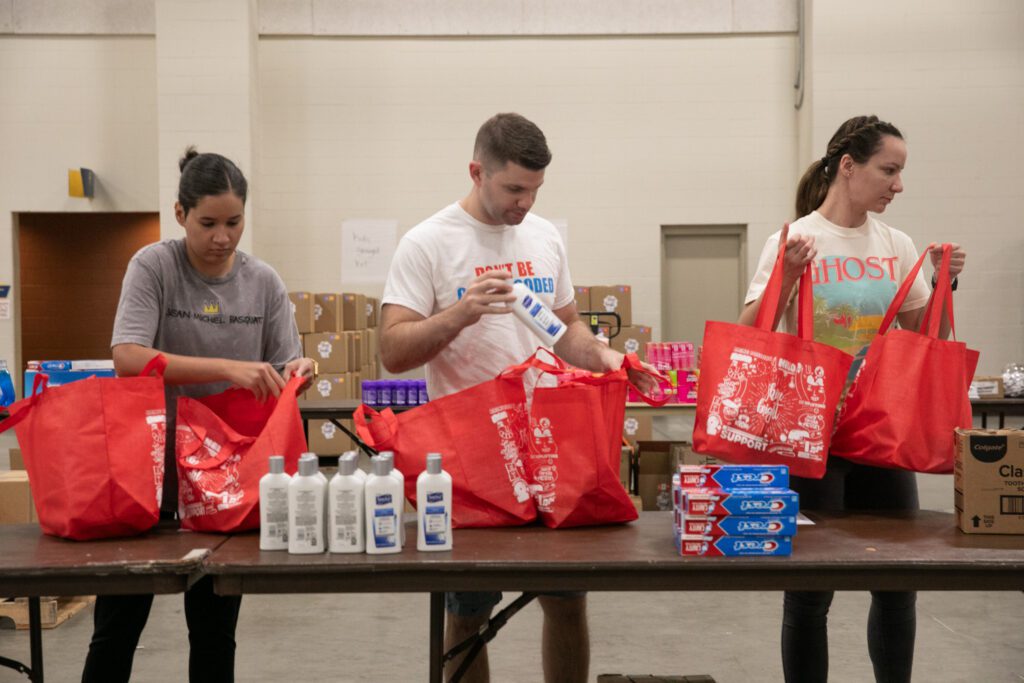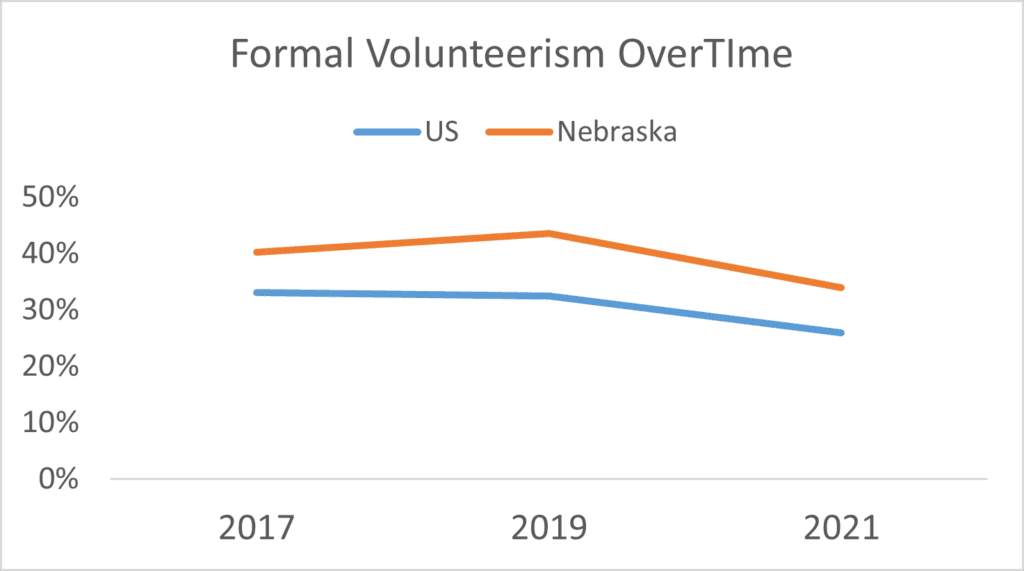Giving and Volunteering
-
They say if you can’t donate money, donate your time, but often these go hand in hand
-
Volunteerism has been decreasing for the last 20 years and is not just a pandemic effect
-
Individual giving decreased 13.4% last year – and has only fallen three other times in the last 40 years
-
Skills-based volunteerism creates a strong sense of contribution, motivating giving and advancing a spirit of community buy in
While nonprofits work to strengthen communities and fill gaps in resources for those who need them most, the rest of us must decide what role we can play. Charitable giving was especially strong in 2020 and 2021 as donors rallied to address increasing needs amid a global pandemic and economic crisis. But the Giving USA report for 2023 shows total giving decreased in 2022, a relatively rare occurrence. This decrease is further magnified by changes to volunteerism over time. Beyond the disruption from the pandemic, some argue a slow downward trend in volunteering has been in motion for the past 20 years. Rates for volunteering in 2005 at 28.8% dropped to 25.3% by 2018. With the current rate down to 23%, it is hard to know what a rebound for volunteerism will look like.
They say if you can’t donate money, donate your time, but often these go hand in hand. New ways of giving and new generations may be changing how people and companies lift up their communities. Understanding the relationship between giving and volunteerism will only help us better inspire others in finding their role.

And with the current hourly value of volunteerism as high as $29.50 in Nebraska, people may have more to offer than they think.
Although Nebraska truly is a state of giving when compared to others, our volunteerism appears to be slowing down over the past 20 years. UNL Polling found that rurally, volunteerism is incredibly high with 70% giving their time in the past year to charitable work. Statewide, the recent census showed that 33.9% of Nebraskans formally volunteer time, ranking it 7th nationally. Even more striking is Nebraska’s 2nd place ranking for “informal” helping with 66.4% of our residents going out of their way to lend a hand. While Nebraska’s generosity of time is exceptional, our volunteerism was once much stronger across the state, at over 40% in 2017.
DID YOU KNOW?
UWM facilitated 38,000+ volunteer hours valued at $1.1M for our community (2022-2023)
Explore Volunteer Opportunities
In the meantime, Nebraska nonprofits are left to shoulder the burden of meeting needs. Amplifying the struggle are staffing shortages as 1 in 3 are operating with job vacancies at 20% or higher. A survey conducted by the National Council of Nonprofits finds a large portion of these unfilled positions are required to properly function and deliver services. With these challenges it is little surprise that roughly 25% of organizations report having longer wait times for services than prior to March of 2020.
Nonprofits in Omaha made the news this year as they struggled to meet the high demand for essential resources. With the additional funds from the pandemic stopped and inflation swelling the costs to operate and provide goods, organizations are struggling to fundraise what they need to serve the increased number of families seeking assistance. (Read more about the availability of community resources here.)
"Whether you're somebody walking through the door asking for help, whether you're the organization that's trying to procure the food or you're the food bank that is our major food sourcing partner, all of us are really adjusting to this new landscape."
Mike Hornacek, President & CEO, Together
Giving by individuals is down 13.4% nationally – and in 40 years charitable giving has fallen only three other times. As we face economic headwinds as a community, it becomes even more critical for people to give and recognize that any contribution can make a meaningful difference. Locally in Nebraska, more than 3 out of 5 (65.3%) nonprofits expect their donations will decline or remain flat for 2023.
While organizations are faced with trying to do more for our communities with less, understanding patterns in giving can be an asset. People thinking about getting involved often wonder what is better, time or money? But these are not the only options, and the data shows people of all socio-economic status have something valuable to offer.
Those without deep pockets or blank schedules should know, that’s okay – a little of either or both can go a long way.
It’s also incredibly common for people to give both time and money when they can. A 2022 report from CCS Fundraising found that 68% of donors also volunteered and 76% donated to the nonprofits where they volunteered their time. The Global Trend in Giving report was cited to have found 85% of their volunteers donated money. Beyond the likelihood of doing one if doing the other, is that volunteers spend up to 56% more money when giving according to the Chronicle of Philanthropy. It’s also important to consider the fact that two thirds of people who volunteer do so for two or more organizations according to the most recent report on volunteerism with Fidelity Charitable.
Of our volunteers with United Way of the Midlands, we found an average of 48% also donated personal funds. When examining our own volunteers and donors it was important to distinguish our volunteer roles which vary by intensity. High-intensity volunteer roles are those that require significant investments of time and professional skill which include members of our various committees, the Board of Directors, CIRT team leaders and Campaign Cabinet. When comparing these groups, high-intensity volunteers gave more money and more often than more episodic, low-intensity volunteers who provide a few hours of support to specific projects that are typically done in a day.
Research suggests that more volunteering leads to more giving, and our own data shows that volunteers involved in higher-commitment roles give more than volunteers who participate in short projects. However, our data reveals that more frequent episodes of volunteer participation actually align with smaller donation amounts.
These volunteers appeared to balance their gifts in money against time volunteered, giving higher amounts when volunteering less and vice versa. The pattern certainly reflects the fact that money and time are inversely proportional for most people. In other words, having more of one tends to mean having less of the other – especially for episodic, one-time events. What is striking is the flexibility of giving, whether that is $20, $20,000, one event or a dozen – people exercise their options. But how people choose to manage their gifts really depends on who you ask.
While the vast majority of people of any age report their donations aren’t affected by their volunteering, that may be changing. Recent survey research found that the younger the generation, the more likely people were to report that they’d give less if they didn’t volunteer. Looking ahead, the experience of volunteering may be increasingly important for overall engagement.
While dedicating time is a key asset to many organizations, some are trying to take that a step further.
A growing trend is the offering of specialized skills to support organizations. In fact, 40% of those surveyed reported that they preferred in-person volunteer activities over virtual volunteering because they could use more of their specific skillset. Our data and others’ may be pointing to an important feature behind mobilizing communities – building on a personal sense of community.
At United Way, we have seen that those in skilled positions donate more often and at higher levels. Other studies have found skilled volunteerism to be on the rise and more popular with younger cohorts. As more people come to report that volunteering inspires higher donations, the power of skilled volunteerism should be considered for its potential to better engage communities. It is well established that a personal sense of community drives giving. When seeking to predict volunteerism, research found “a psychological sense of community” (PSOC) was the most powerful feature in predicting ongoing volunteerism. This sense of community was even more powerful than a person’s own passion for a specific cause. Perhaps tapping into one’s personal expertise and skills elevates our sense of impact and sense of responsibility. The relationship between giving and volunteerism is strong. While data suggests that volunteering may be an increasingly important path toward giving, doing so by tapping into people’s specific gifts may be even more powerful.
Sources:
AmeriCorps State Volunteerism Trends Over Time, based on data collected in September of 2017 2019 and 2021.
CCS Fundraising: Guide to Philanthropy in the U.S., Philanthropic Landscape 2022.
Value of Volunteer Time, April 2023.
The Chronicle of Philanthropy: Data Shows Correlation Between Volunteerism and Giving, September 2018.
Volunteer Hub: The Thin Line Between Financial Donors and Volunteers, October 2018.
Fidelity Charitable: The Role of Volunteering in Philanthropy, 2020.
Fidelity Charitable: Time and Money, The Role of Volunteering in Philanthropy, 2014.
Giving USA 2023: The Annual Report on Philanthropy, 2022.
University of Nebraska-Lincoln: Rural Poll: Community Size, Age Impact Volunteerism in Nebraska, May 2023.
U.S. Census Bureau: Volunteering in America, January 2023.
Gallup: U.S. Charitable Donations Rebound; Volunteering Still Down, January 2022.
Bloomerang: 20 Volunteer Statistics Every Nonprofit Should Know
Civic Champs: The State of Nonprofit Volunteerism, March 2023